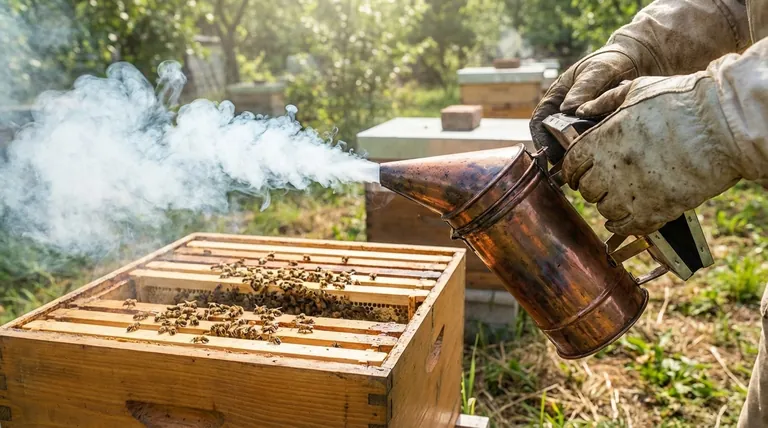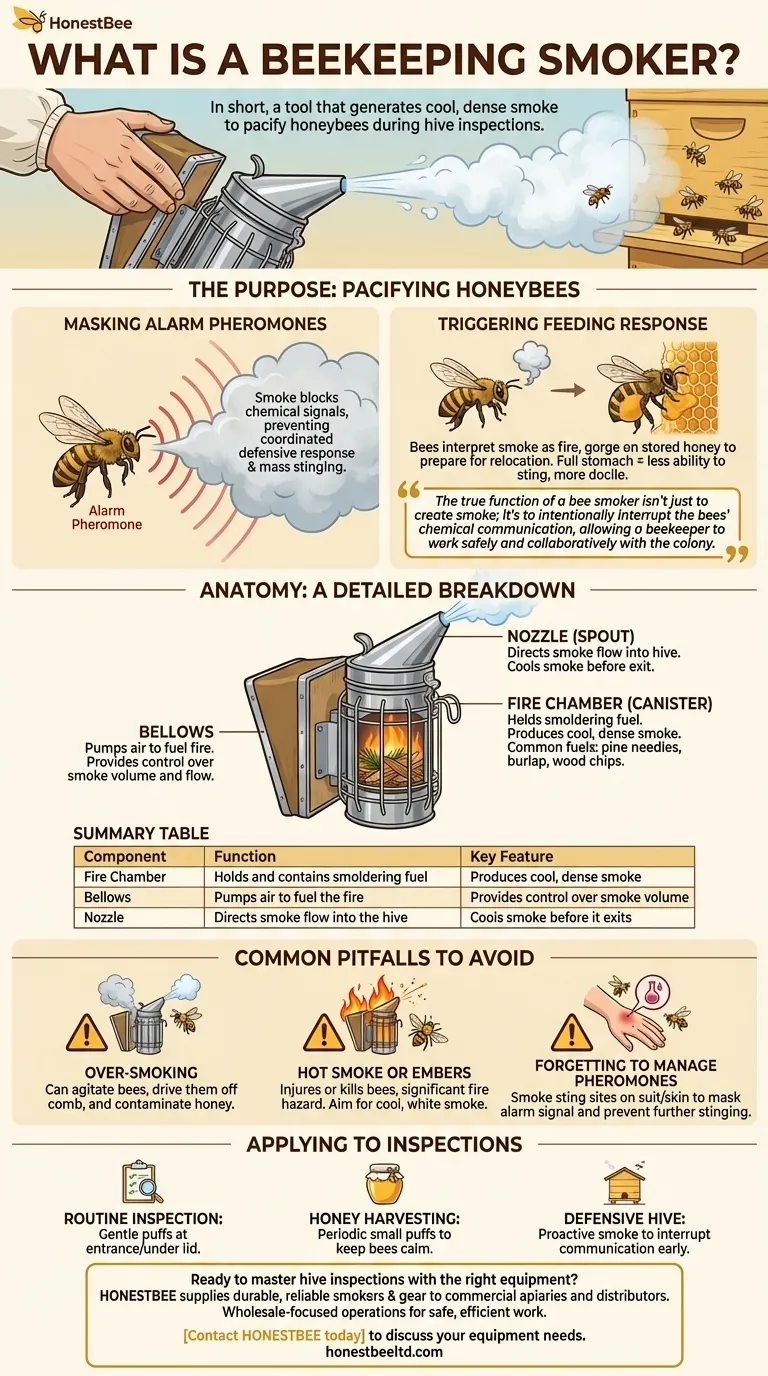In short, a beekeeping smoker is a tool that generates cool, dense smoke to pacify honeybees during hive inspections. It consists of three primary components: a fire chamber to hold fuel, a bellows to pump air, and a nozzle to direct the smoke. The smoke masks the bees' alarm signals and encourages them to eat honey, making them calmer and less likely to sting.
The true function of a bee smoker isn't just to create smoke; it's to intentionally interrupt the bees' chemical communication, allowing a beekeeper to work safely and collaboratively with the colony.

The Purpose of a Bee Smoker
A smoker is one of the most essential tools in beekeeping. Its proper use ensures that hive inspections, maintenance, and honey harvesting are less stressful for both the beekeeper and the bees.
Masking Alarm Pheromones
When a honeybee feels threatened or stings, it releases an alarm pheromone. This chemical signal instantly alerts other bees to the perceived danger, often triggering a coordinated defensive response.
The dense smoke from a smoker effectively masks these pheromones, preventing the alarm from spreading throughout the colony. This interruption of communication is the primary reason it is so effective at preventing mass stinging.
Triggering a Feeding Response
Smoke also triggers a primal, instinctual response in honeybees. They interpret the smoke as a sign of a potential forest fire threatening their hive.
In response, the bees will begin to gorge on stored honey to prepare for a possible relocation. A bee with a full stomach is physically less able to flex its abdomen to sting and is generally more docile and preoccupied.
Anatomy of the Smoker: A Detailed Breakdown
A beekeeping smoker is a simple yet highly effective device. Its design is centered around producing a steady stream of cool, not hot, smoke.
The Fire Chamber (Canister)
This is the metal body of the smoker where the fuel is placed and ignited. It is designed to contain the heat and safely house the smoldering material.
Commonly used fuels are organic and slow-burning, such as pine needles, wood chips, dried leaves, or burlap. The goal is to produce smoke, not flames.
The Bellows
The bellows is a manually operated air pump attached to the side of the fire chamber. Squeezing the bellows forces a puff of fresh air into the bottom of the chamber.
This injection of oxygen keeps the fuel smoldering and pushes the resulting cool smoke out through the nozzle. It gives the beekeeper precise control over the volume and flow of smoke.
The Nozzle (Spout)
The nozzle is a cone-shaped spout at the top of the smoker. It cools the smoke as it exits the fire chamber and allows the beekeeper to direct it accurately, such as into the hive entrance or between frames.
Common Pitfalls to Avoid
While indispensable, a smoker must be used with care and understanding. Improper use can be ineffective or even harmful to the colony.
The Risk of Over-Smoking
Using too much smoke can be counterproductive. It can overly agitate the bees, drive them off the comb, and potentially contaminate honey with a smoky flavor. A few gentle puffs are usually sufficient.
The Danger of Hot Smoke or Embers
The objective is always cool, white smoke. If the smoker is producing hot smoke, flames, or sparks, the fuel is burning too quickly. This can injure or kill the bees and presents a significant fire hazard.
Forgetting to Manage the Pheromones
If you are stung, that specific area is now marked with alarm pheromone. It's wise to smoke the spot on your suit or skin where the sting occurred to mask the signal and prevent other bees from targeting the same area.
Applying This to Your Hive Inspections
How you use a smoker depends entirely on your objective for opening the hive.
- If your primary focus is a quick, routine inspection: A few gentle puffs at the hive entrance and another few under the lid after cracking it open will be enough to calm the colony.
- If your primary focus is a longer task like honey harvesting: You may need to apply small amounts of smoke periodically to keep the bees calm as you work through the different sections of the hive.
- If your primary focus is managing a defensive hive: Use smoke proactively to interrupt their communication early and be prepared to puff the area around a sting to prevent a chain reaction.
Ultimately, the smoker is a tool that transforms a potentially confrontational interaction into a manageable one.
Summary Table:
| Component | Function | Key Feature |
|---|---|---|
| Fire Chamber | Holds and contains smoldering fuel | Produces cool, dense smoke |
| Bellows | Pumps air to fuel the fire | Provides control over smoke volume |
| Nozzle | Directs smoke flow into the hive | Cools smoke before it exits |
Ready to master hive inspections with the right equipment?
HONESTBEE supplies durable, reliable beekeeping smokers and essential gear to commercial apiaries and beekeeping equipment distributors. Our wholesale-focused operations ensure you get the high-quality tools you need to work safely and efficiently with your colonies.
Contact HONESTBEE today to discuss your equipment needs and elevate your beekeeping practice.
Visual Guide

Related Products
- Premium Traditional Copper Bee Smoker with Bellows
- Economy Galvanized Beekeeping Honey Bee Smoker for Wholesale
- Stainless Steel Honey Bee Smoker Hive and Honeycomb Smoker for Beekeeping
- European Stainless Steel Bee Smoker for Honey Bee Hive
- Heavy Duty Manual Bee Smoker Blower for Beekeeping
People Also Ask
- What is a Smoker and how is it used in beekeeping? The Essential Tool for Calm, Safe Hive Inspections
- What happens to bees when they sense smoke? Unlock the Secret to Calm Hive Inspections
- What are some alternatives to using smoke in beekeeping? A Guide to Gentle Hive Management
- What is the primary purpose of using smoke in beekeeping? Calm Bees for Safer Hive Management
- What are the main components of a bee smoker? A Guide to Safe and Effective Hive Management



















